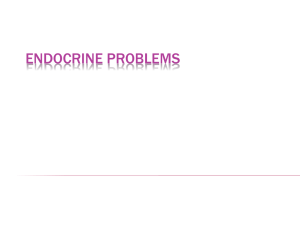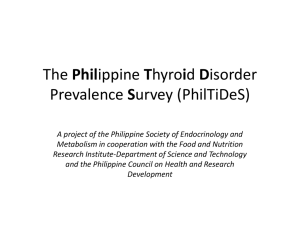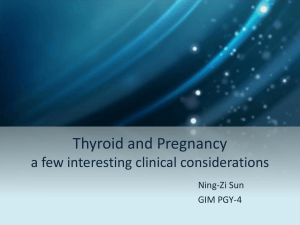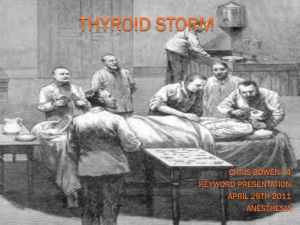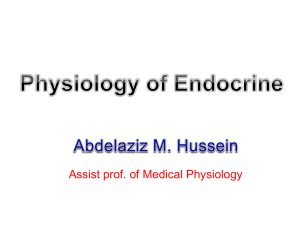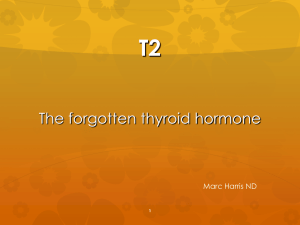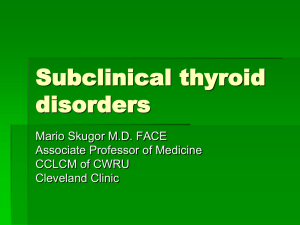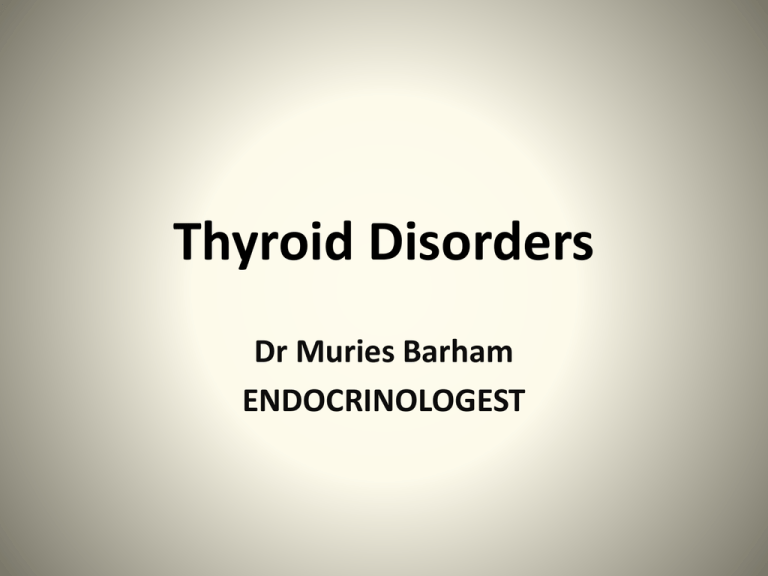
Thyroid Disorders
Dr Muries Barham
ENDOCRINOLOGEST
Thyroid Disorders
• Anatomy
The thyroid gland consists of two lateral
lobes connected by an isthmus. It is closely
attached to the thyroid cartilage and to the
upper end of the trachea, and thus moves on
swallowing.It is often palpable in normal
women.
• The normal thyroid is 12–20 g in size, highly
vascular, and soft in consistency. Four
parathyroid glands, which produce PTH,are
located posterior to each pole of the thyroid.
The recurrent laryngeal nerves traverse the
lateral borders of the thyroid gland and must
be identified during thyroid surgery to avoid
injury and vocal cord paralysis.
• Synthesis. The thyroid synthesizes two
hormones, L-thyroxine (T4) and
triiodothyronine (T3), of which T3 acts at the
cellular level and T4 is the prohormone.
The thyroid axis is a classic example of an
endocrine feedback loop. Hypothalamic TRH
stimulates pituitary production of TSH, which,
in turn, stimulates thyroid hormone synthesis
and secretion.
• Thyroid hormones, acting predominantly
through thyroid hormone receptor 2 (TR2),
feed back to inhibit TRH and TSH production.
The "set-point" in this axis is established by
TSH.
TRH is the major positive regulator of TSH
synthesis and secretion. Peak TSH secretion
occurs 15 min after administration of
exogenous TRH. Dopamine, glucocorticoids,
and somatostatin suppress TSH but are not of
major physiologic importance except when
these agents are administered in
pharmacologic doses
Thyroid function tests
• TSH levels can discriminate between
hyperthyroidism, hypothyroidism and
euthyroidism. There are pitfalls, however.
These are mainly with hypopituitarism, with
the ‘sick euthyroid’ syndrome, all of which
may give ‘false’ ,low results implying
hyperthyroidism.
• As a single test of thyroid function it is the
most sensitive in most circumstances, but
accurate diagnosis requires at least two tests –
for example, TSH plus free T4 or free T3 where
hyperthyroidism is suspected, TSH plus serum
free T4 where hypothyroidism is likely
Causes of Hypothyroidism
• Primary Autoimmune hypothyroidism: Hashimoto's
thyroiditis, atrophic thyroiditis
• Iatrogenic: 131I treatment, subtotal or total
thyroidectomy, external irradiation of neck for
lymphoma or cancer
• Drugs: iodine excess (including iodine-containing
contrast media and amiodarone), lithium, antithyroid
drugs, p-aminosalicylic acid, interferon- and other
cytokines, aminoglutethimide, sunitinib
• Congenital hypothyroidism: absent or ectopic thyroid
gland, dyshormonogenesis, TSH-R mutation
Causes of Hypothyroidism
Iodine deficiency
Infiltrative disorders: amyloidosis, sarcoidosis,
hemochromatosis, scleroderma, cystinosis,
Riedel's thyroiditis
Transient -Silent thyroiditis, including postpartum
thyroiditis ,Subacute thyroiditis
-Withdrawal of thyroxine treatment in individuals
with an intact thyroid
- After 131I treatment or subtotal thyroidectomy for
Graves' disease
Causes of Hypothyroidism
Secondary
-Hypopituitarism: tumors, pituitary surgery or
irradiation, infiltrative disorders, Sheehan's
syndrome, trauma, genetic forms of combined
pituitary hormone deficiencies
-Isolated TSH deficiency or inactivity
-Hypothalamic disease: tumors, trauma,
infiltrative disorders, idiopathic
Essentials of Diagnosis
•
•
•
•
•
•
•
•
•
•
•
•
Symptoms
Tiredness, weakness
Dry skin
Feeling cold
Hair loss
Difficulty concentrating and poor memory
Constipation
Weight gain with poor appetite
Dyspnea
Hoarse voice
Menorrhagia (later oligomenorrhea or amenorrhea)
Paresthesia
Impaired hearing
Signs
•
•
•
•
•
•
•
•
Dry coarse skin; cool peripheral extremities
Puffy face, hands, and feet (myxedema)
Diffuse alopecia
Bradycardia
Peripheral edema
Delayed tendon reflex relaxation
Carpal tunnel syndrome
Serous cavity effusions
Atrophic (autoimmune) hypothyroidism.
This is the most common cause of hypothyroidism and
is associated with antithyroid autoantibodies leading to
lymphoid infiltration of the gland and eventual atrophy
and fibrosis. It is six times more common in females
and the incidence increases with age. The condition is
associated with other autoimmune disease such as
pernicious anaemia, vitiligo and other endocrine
deficiencies . In some instances intermittent
hypothyroidism occurs with recovery from disease;
antibodies which block the TSH receptor may
sometimes be involved in the aetiology.
Hashimoto’s thyroiditis
This form of autoimmune thyroiditis,again
more common in women and most common
in late middle age, produces atrophic changes
with regeneration,leading to goitre formation.
The gland is usually firm and rubbery but may
range from soft to hard.
Hashimoto’s thyroiditis
• TPO antibodies are present, often in very high
titres (> 1000 IU/L). Patients may be
hypothyroid or euthyroid, though they may go
through an initial toxic phase, ‘Hashi-toxicity’.
Levothyroxine therapy may shrink the goitre
even when the patient is not hypothyroid.
Postpartum thyroiditis
This is usually a transient phenomenon
observed following pregnancy. It may cause
hyperthyroidism , hypothyroidism or the two
sequentially. It is believed to result from the
modifications to the immune system
necessary in pregnancy, and histologically is a
lymphocytic thyroiditis.
Postpartum thyroiditis
• The process is normally self-limiting, but when
conventional antibodies are found there is a
high chance of this proceeding to permanent
hypothyroidism. Postpartum thyroiditis may
be misdiagnosed as postnatal depression
Subacute Thyroiditis
• Subacute thyroiditis(de Quervain's Thyroiditis;
Giant Cell Thyroiditis; Granulomatous
Thyroiditis) is an acute inflammatory disease
of the thyroid probably caused by a virus.
Symptoms include fever and thyroid
tenderness. Initial hyperthyroidism is
common, sometimes followed by a transient
period of hypothyroidism
Subacute Thyroiditis
• History of an antecedent viral URI is
common.
• Diagnosis is clinical and with thyroid function
tests.
• Treatment is with high doses of NSAIDs or
with corticosteroids. The disease usually
resolves spontaneously within months.
Subacute Thyroiditis
• Symptoms and Signs
There is pain in the anterior neck and fever
of 37.8° to 38.3° C. Neck pain characteristically
shifts from side to side and may settle in one
area, frequently radiating to the jaw and ears.
Defects of hormone synthesis
• Iodine deficiency. Dietary iodine deficiency
still exists in some areas. The patients may be
euthyroid or hypothyroid depending on the
severity of iodine deficiency
• Dyshormonogenesis. This rare condition is
due to genetic defects in the synthesis of
thyroid hormones; patients develop
hypothyroidism with a goitre.
Myxedema Coma
• uncommon but life-threatening form of
untreated hypothyroidism . The condition
occurs in patients with long-standing,
untreated hypothyroidism.
Myx. Coma-Precipitating factors
• CNS depressants(barbiturates,
phenothiazines, narcotics, anaesthetics)
• Infections
• Trauma
• Hypothermia
• Hypoventilation
• Old age
Hypothyroidism & Myxedema Coma
• Myxedema Coma Findings:
– Decrease mental status – from baseline
– Hypothermia/ Hypoglycemia/ Hyponatremia
– Bradycardia(soft distant heart sounds,enlarged
heart with or without pericardial effusion).
– Hypoventillation
– Peri-orbital edema
– Non-pitting Edema
– Delayed Tendon Reflexes
Management of Myxedema
• ICU admission may be required for
ventilatory support and IV medications
• levothyroxine intravenously (myxedema
itself can interfere with levothyroxine's
intestinal absorption).
– Loading dose of 300 – 400 μg
– Then 50 μg daily
• The hypothermic patient is warmed only with
blankets, since faster warming can precipitate
cardiovascular collapse.
• Patients with hypercapnia require intubation
and assisted mechanical ventilation.
• Infections must be detected and treated
aggressively.
Management of Myxedema
• Electrolytes
– Hypertonic saline or IV glucose may be needed
if there is severe hyponatremia or
hypoglycemia; hypotonic IV fluids should be
avoided because they may exacerbate water
retention secondary to reduced renal perfusion
and inappropriate vasopressin secretion
• Avoid sedation
Prognosis of Myxedema
• Glucocorticoids - Parenteral hydrocortisone
(50 mg every 6 h) should be administered,
because there is impaired adrenal reserve in
profound hypothyroidism.for 1 week, then
taper.
• Mortality is 20%, and is mostly due to
underlying and precipitating diseases
• Before therapy with thyroid hormone is
commenced, the hypothyroid patient requires
at least a clinical assessment for adrenal
insufficiency, for which the patient would
require evaluation and concurrent treatment.
Thyrotoxicosis
• Thyrotoxicosis is defined as the state of
thyroid hormone excess and is not
synonymous with hyperthyroidism, which is
the result of excessive thyroid function.
Causes of Thyrotoxicosis
• Primary hyperthyroidism
1-Graves' disease
2-Toxic multinodular goiter
3-Toxic adenoma Functioning thyroid carcinoma
metastases
4- Activating mutation of the TSH receptor
5- Activating mutation of Gs (McCune-Albright
syndrome)
6-Struma ovarii
7-Drugs: iodine excess (Jod-Basedow phenomenon)
Thyrotoxicosis without
hyperthyroidism
• Subacute thyroiditis
• Silent thyroiditis
• Other causes of thyroid destruction:
amiodarone, radiation, infarction of adenoma
• Ingestion of excess thyroid hormone
(thyrotoxicosis factitia) or thyroid tissue
Secondary hyperthyroidism
• TSH-secreting pituitary adenoma
• Thyroid hormone resistance syndrome:
occasional patients may have features of
thyrotoxicosis
• Chorionic gonadotropin-secreting tumors
• Gestational thyrotoxicosis
Graves' Disease
• Graves' disease accounts for 60–80% of
thyrotoxicosis. The prevalence varies among
populations, reflecting genetic factors and
iodine intake (high iodine intake is associated
with an increased prevalence of Graves'
disease).
• Graves' disease occurs in up to 2% of women
but is one-tenth as frequent in men. The
disorder rarely begins before adolescence and
typically occurs between 20 and 50 years of
age; it also occurs in the elderly.
• Graves' disease is currently viewed as an
autoimmune disease of unknown cause.
There is a strong familial predisposition in that
about 15% of patients with Graves' disease
have a close relative with the same disorder,
and about 50% of relatives of patients with
Graves' disease have circulating thyroid
autoantibodies.
. Proposed environmental triggers include
stress, tobacco use, infection, and iodine
exposure. The postpartum state, which may
be associated with heightened immune
function, also may trigger the development of
Graves' disease in genetically susceptible
women.
Symptoms
•
•
•
•
•
•
•
•
Hyperactivity, irritability, dysphoria
Heat intolerance and sweating
Palpitations
Fatigue and weakness
Weight loss with increased appetite
Diarrhea
Polyuria
Oligomenorrhea, loss of libido
Signs
•
•
•
•
•
•
•
•
Tachycardia; atrial fibrillation in the elderly
Tremor
Goiter
Warm, moist skin
Muscle weakness, proximal myopathy
Lid retraction or lag
Gynecomastia
ophthalmopathy and dermopathy
• Graves' disease is caused by an autoantibody
against the thyroid receptor for thyroidstimulating hormone (TSH); unlike most
autoantibodies, which are inhibitory, this
autoantibody is stimulatory, thus causing
continuous synthesis and secretion of excess
T4 and T3.
• Graves' disease (like Hashimoto's thyroiditis)
sometimes occurs with other autoimmune
disorders, including type 1 diabetes mellitus,
vitiligo, premature graying of hair, pernicious
anemia, connective tissue diseases, and
polyglandular deficiency syndrome.
• The pathogenesis of infiltrative
ophthalmopathy (responsible for the
exophthalmos in Graves' disease) is poorly
understood but may result from
immunoglobulins directed to specific
receptors in the orbital fibroblasts and fat that
result in release of proinflammatory cytokines,
inflammation, and accumulation of
glycosaminoglycans
• Ophthalmopathy may also occur before the
onset of hyperthyroidism or as late as 20 yr
afterward and frequently worsens or abates
independently of the clinical course of
hyperthyroidism.
Treatment: Graves' Disease
• Graves' disease is treated by reducing thyroid
hormone synthesis, using antithyroid drugs, or
reducing the amount of thyroid tissue with
radioiodine (131I) treatment or by thyroidectomy.
Antithyroid drugs are the predominant therapy in
many centers in Europe and Japan, whereas
radioiodine is more often the first line of
treatment in USA. No single approach is optimal
and that patients may require multiple
treatments to achieve remission.
• The common side effects of antithyroid drugs
are rash, urticaria, fever, and arthralgia (1–5%
of patients). These may resolve spontaneously
or after substituting an alternative antithyroid
drug.
• Rare but major side effects include hepatitis;
an SLE-like syndrome; and, most important,
agranulocytosis (<1%). It is essential that
antithyroid drugs are stopped and not
restarted if a patient develops major side
effects.
• symptoms of possible agranulocytosis (e.g.,
sore throat, fever, mouth ulcers) and the
need to stop treatment pending a complete
blood count to confirm that agranulocytosis is
not present.
• Beta blockers (Propranolol (20–40 mg every 6
h) or longer-acting such as atenolol), may be
helpful to control adrenergic symptoms,
especially in the early stages before
antithyroid drugs take effect. The need for
anticoagulation with Warfarin should be
considered in all patients with atrial
fibrillation.
Radioiodine
• causes progressive destruction of thyroid cells
and can be used as initial treatment or for
relapses after a trial of antithyroid drugs.
There is a small risk of thyrotoxic crisis after
radioiodine, which can be minimized by
pretreatment with antithyroid drugs for at
least a month before treatment.
• Antithyroid drugs should be considered for all
elderly patients or for those with cardiac
problems to deplete thyroid hormone stores
before administration of radioiodine.
Carbimazole or methimazole must be stopped
at least 2 days before radioiodine
administration to achieve optimum iodine
uptake.
Thyrotoxic crisis, or thyroid storm
• Is rare and presents as a life-threatening
exacerbation of hyperthyroidism,
accompanied by fever, delirium, seizures,
coma, vomiting, diarrhea, and jaundice. The
mortality rate due to cardiac failure,
arrhythmia, or hyperthermia is as high as 30%,
even with treatment.
• Thyrotoxic crisis is usually precipitated by
acute illness (e.g., stroke, infection, trauma,
diabetic ketoacidosis), surgery (especially on
the thyroid), or radioiodine treatment of a
patient with partially treated or untreated
hyperthyroidism.
• Management requires intensive monitoring
and supportive care, identification and
treatment of the precipitating cause, and
measures that reduce thyroid hormone
synthesis. Large doses of Antithyroid drugs
should be given orally or by nasogastric tube.
• One hour after the first dose of antithyroid
drug. A saturated solution of potassium iodide
(5 drops SSKI every 6 h).
• Propranolol should also be given to reduce
tachycardia and other adrenergic
manifestations (40–60 mg PO every 4 h; or 2
mg IV every 4 h). Although other -adrenergic
blockers can be used, high doses of
propranolol decrease T4 T3 conversion, and
the doses can be easily adjusted.
• Additional therapeutic measures include
glucocorticoids (e.g., dexamethasone, 2 mg
every 6 h), antibiotics if infection is present,
cooling, oxygen, and intravenous fluids.
Subclinical hyperthyroidism
• Patients with serum TSH < 0.1 mU/L have an
increased incidence of atrial fibrillation
(particularly elderly patients), reduced bone
mineral density, increased fractures, and
increased mortality. Patients with serum TSH
that is only slightly below normal are less
likely to have these features.
Subclinical hyperthyroidism
• Many patients with subclinical hyperthyroidism
are taking L-thyroxine; in these patients,
reduction of the dose is the most appropriate
management unless therapy is aimed at
maintaining a suppressed TSH in patients with
thyroid cancer or nodules. The other causes of
subclinical hyperthyroidism are the same as those
for clinically apparent hyperthyroidism.
Subclinical hyperthyroidism
• Therapy is indicated for patients with
endogenous subclinical hyperthyroidism
(serum TSH < 0.1 mU/L), especially those with
atrial fibrillation or reduced bone mineral
density. The usual treatment is 131I. In patients
with milder symptoms (eg, nervousness), a
trial of antithyroid drug therapy is worthwhile.
Subclinical Hypothyroidism
• Subclinical hypothyroidism is elevated serum TSH in
patients with absent or minimal symptoms of
hypothyroidism and normal serum levels of free T4.
• Subclinical thyroid dysfunction is relatively common; it
occurs in more than 15% of elderly women and 10% of
elderly men, particularly in those with underlying
Hashimoto's thyroiditis.
Subclinical Hypothyroidism
• In patients with serum TSH > 10 mU/L, there is
a high likelihood of progression to overt
hypothyroidism with low serum levels of free
T4 in the next 10 yr. These patients are also
more likely to have hypercholesterolemia and
atherosclerosis. They should be treated with Lthyroxine, even if they are asymptomatic
Subclinical Hypothyroidism
• For patients with TSH levels between 4.5 and
10 mU/L, a trial of L-thyroxine is reasonable if
symptoms of early hypothyroidism (eg,
fatigue, depression) are present. L-Thyroxine
therapy is also indicated in pregnant women
and in women who plan to become pregnant
to avoid deleterious effects of hypothyroidism
on the pregnancy and fetal development.
Subclinical Hypothyroidism
• Patients should have annual measurement of
serum TSH and free T4 to assess progress of
the condition if untreated or to adjust the Lthyroxine dosage
Approach to the Patient With a Thyroid Nodule
• Thyroid nodules are common, increasingly so
with increasing age. In middle-aged and
elderly patients, palpation reveals nodules in
about 5%. Results of ultrasonography and
autopsy studies suggest that nodules are
present in about 50% of adults. Many nodules
are found incidentally on thyroid imaging
studies done for other disorders.
Etiology
• Most nodules are benign.
• Benign causes include hyperplastic colloid
goiter, thyroid cysts, thyroiditis, and thyroid
adenomas. Malignant causes include thyroid
cancers.
Evaluation
• History: Pain suggests thyroiditis or
hemorrhage into a cyst. An asymptomatic
nodule may be malignant. Symptoms of
hyperthyroidism suggest a hyperfunctioning
adenoma or thyroiditis, whereas symptoms of
hypothyroidism suggest Hashimoto's
thyroiditis.
Risk factors for thyroid cancer
• History of thyroid irradiation, especially in infancy or childhood
• Age < 20 yr
• Male sex
• Family history of thyroid cancer or multiple endocrine neoplasia
• A solitary nodule
• Dysphagia
• Dysphonia
• Increasing size (particularly rapid growth or growth while receiving
thyroid suppression treatment).
• Physical examination: Signs that suggest
thyroid cancer include stony hard consistency
or fixation to surrounding structures, cervical
lymphadenopathy, and hoarseness due to
recurrent laryngeal nerve paralysis.
• If TSH is suppressed, radioiodine scanning is
done. Nodules with increased radionuclide
uptake (hot) are seldom malignant. If thyroid
function tests do not indicate hyperthyroidism
or Hashimoto's thyroiditis, or if nodules are
indeterminate or cold, FNA biopsy is done to
distinguish benign from malignant nodules.
• Ultrasonography is useful in determining the
size of the nodule but is rarely diagnostic of
cancer .Fine-needle aspiration biopsy is not
routinely indicated for nodules < 1 cm on
ultrasonography.
THANK YOU


